by Eric Meier
When attempting to identify a wood sample, it’s important to keep in mind the limitations and obstacles that are present in our task. Before starting, please have a look at The Truth Behind Wood Identification to approach the task in a proper mindset; I consider the linked article to be required reading for all those visiting my site with the intent of identifying wood.
1. Confirm it is actually solid wood.
Before proceeding too much farther into the remaining steps, it’s first necessary to confirm that the material in question is actually a solid piece of wood, and not a man-made composite or piece of plastic made to imitate wood.
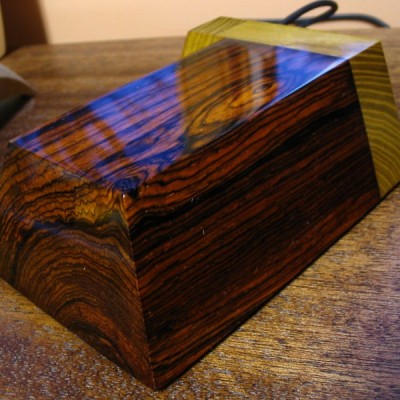
Can you see the end-grain?
Manufactured wood such as MDF, OSB, and particleboard all have a distinct look that is—in nearly all cases—easily distinguishable from the endgrain of real wood. Look for growth rings—formed by the yearly growth of a tree—which will be a dead-giveaway that the wood sample in question is a solid, genuine chunk of wood taken from a tree.
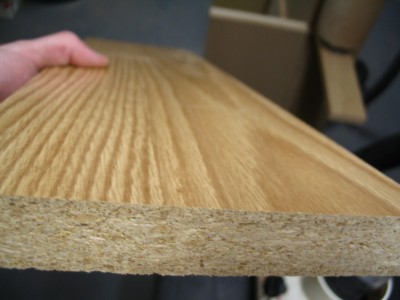
Is it veneered?
If you see a large panel that has a repeating grain pattern, it may be a veneer. In such cases, a very thin layer of real wood is peeled from a tree and attached to a substrate; sometimes the veneer can be one continuous repeating piece because it is rotary-sliced to shave off the veneer layer as the tree trunk is spun by machines. Assuming it is a real wood veneer with a distinct grain and texture—and not merely a piece of printed plastic—you may still be able to identify the outer veneer wood in question, but you should still realize that is it only a veneer and not a solid piece of wood.
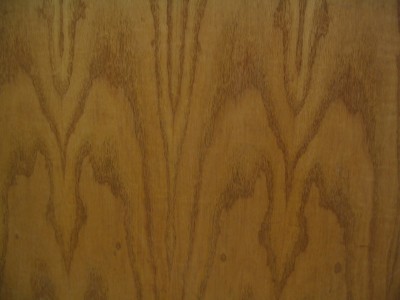
Is it painted or printed to look like wood?
Many times, especially on medium to large-sized flat panels for furniture, a piece of particleboard or MDF is either laminated with a piece of wood-colored plastic, or simply painted to look like wood grain. Many of today’s interior hardwood flooring planks are good examples of these pseudo-wood products: they are essentially a man-made material made of sawdust, glues, resins, and durable plastics.
2. Look at the color.
Some questions to immediately ask yourself:
Is the color of the wood natural, or is it stained?
If there is even a chance that the color isn’t natural, the odds are increased that the entire effort of identifying the wood will be in vain.
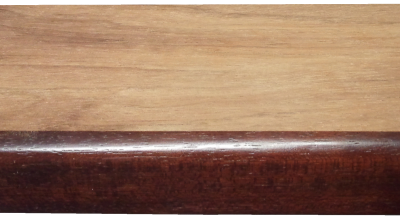
Is it weathered or have a patina?
Many woods, when left outside in the elements, tend to turn a bland gray color. Also, even interior wood also takes on a patina as it ages: some woods get darker, or redder, and some even get lighter or lose their color; but for the most part, wood tends to darken with age.
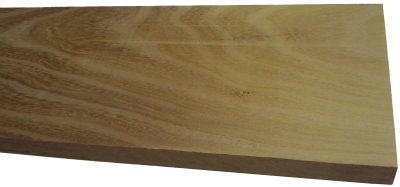
Is it possible to sand or plane the board to see the natural raw color of the wood?
The most predictable baseline to use when identifying wood is in a freshly sanded state. This eliminates the chances of a stain or natural aging skewing the color diagnosis of the wood.
3. Observe the wood grain.
If the wood is unfinished, then look at the texture of the grain. Ask yourself these questions:
Does the wood have an open, porous texture?
Most softwoods will be almost perfectly smooth with no grain indentations, while many common hardwoods have an open pore structure, such as oak or mahogany; though there are some hardwoods that are also smooth to the touch, such as maple.
Can you tell if the wood is quartersawn or plainsawn?
By observing the grain patterns, many times you can tell how the board was cut from the tree. Some wood species have dramatically different grain patterns from plainsawn to quartersawn surfaces. For instance, on their quartersawn surfaces, lacewood has large lace patterns, oak has flecks, and maple has the characteristic “butcher block” appearance.
Is there any figure or unusual characteristics, such as sapwood, curly or wild grain, burl/knots, etc.?
Some species of wood have figure that is much more common than in other species: for example, curly figure is fairly common in soft maple, and the curls are usually well-pronounced and close together. Yet when birch or cherry has a curly grain, it is more often much less pronounced, and the curls are spaced farther apart.
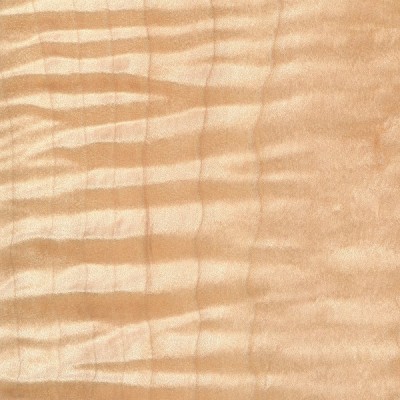
4. Consider the weight and hardness of the wood.
If it’s possible, pick the piece of wood up and get a sense of its weight, and compare it to other known wood species. Try gouging the edge with your fingernail to get a sense of its hardness. If you have a scale, you can take measurements of the length, width, and thickness of the wood, and combine them to find the density of the wood. This can be helpful to compare to other density readings found in the database. When examining the wood in question, compare it to other known wood species, and ask yourself these questions:
Is the wood dry?
Wood from freshly felled trees, or wood that has been stored in an extremely humid environment will have very high moisture contents. In some freshly sawn pieces, moisture could account for over half of the wood’s total weight! Likewise, wood that has been stored in extremely dry conditions of less than 25% relative humidity will most likely feel lighter than average.
How does the wood’s weight compare to other species?
Taking into account the size of the board, how does its weight compare to other benchmark woods? Is it heavier than oak? Is it lighter than pine? Look at the weight numbers for a few wood species that are close to yours, and get a ballpark estimate of its weight.
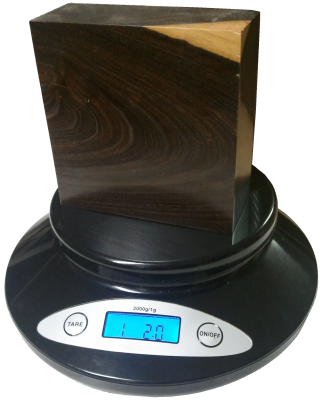
How hard is the wood?
Obviously softwoods will tend to be softer than hardwoods, but try to get a sense of how it compares to other known woods. Density and hardness are closely related, so if the wood is heavy, it will most likely be hard too. If the wood is a part of a finished item that you can’t adequately weigh, you might be able to test the hardness by gouging it in an inconspicuous area. Also, if it is used in a piece of furniture, such as a tabletop, a general idea of its hardness can be assessed by the number and depth of the gouges/dings in the piece given its age and use. A tabletop made of pine will have much deeper dents than a tabletop made of Oak. Additionally, you can always try the “fingernail test” as a rough hardness indicator: find a crisp edge of the wood, and with your fingernail try to push in as hard as you can and see if you’re able to make a dent in the wood.
5. Consider its history.
Many times we forget common sense and logic when attempting to identify wood. If you’ve got a piece of Amish furniture from Pennsylvania, chances are more likely that the wood will be made of something like black walnut or cherry, and not African wenge or jatoba. You might call it “wood profiling,” but sometimes it can pay to be a little prejudiced when it comes to wood identification. Some common-sense questions to ask yourself when trying to identify a piece of wood:
Where did it come from?
Knowing as much as you can about the source of the wood—even the smallest details—can be helpful. If the wood came from a wood pile or a lumber mill where all the pieces were from trees processed locally, then the potential species are immediately limited. If the wood came from a builder of antique furniture, or a boat-builder, or a trim carpenter: each of these occupations will tend to use certain species of woods much more often than others, making a logical guess much simpler.
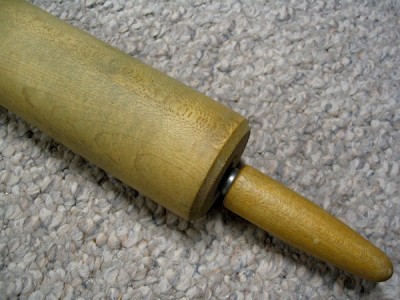
How old is it?
As with the wood’s source, its age will also help in identification purposes. Not only will it help to determine if the wood should have developed a natural patina, but it will also suggest certain species which were more prevalent at different times in history. For instance, many acoustic guitars made before the 1990s have featured Brazilian rosewood backs/sides, yet due to CITES restrictions placed upon that species, East Indian rosewood became a much more common species on newer guitars. (And this is a continuing shift as newer replacements are sought for rosewoods altogether.)
How large is the piece of wood?
Some species of trees are typically very small—some are even considered shrubs—while others get quite large. For instance, if you see a large panel or section of wood that’s entirely black, chances are it’s either painted, dyed, or stained: Gaboon ebony and related species are typically very small and very expensive.
What is the wood’s intended use?
Simply knowing what the wood was intended for—when considered in conjunction with where it came from and how old it is—can give you many clues to help identify it. In some applications, certain wood species are used much more frequently than others, so that you can make an educated guess as to the species of the wood based upon the application where it was used. For instance, in the United States: many older houses with solid hardwood floors have commonly used either red oak or hard maple; many antique furniture pieces have featured quartersawn white oak; many violins have spruce tops; many closet items used aromatic red cedar, and so forth. While it’s not a 100% guarantee, “profiling” the wood in question will help reduce the number of possible suspects, and aid in deducing the correct species.
6. Find the X-Factor.
Sometimes, after all the normal characteristics of a sample have been considered, the identity of the wood in question is still not apparent. In these instances—particularly in situations where a sample has been narrowed down to only a few possible remaining choices—it’s sometimes helpful to bring in specialized tests and other narrower means of identification.
The following techniques and recommendations don’t necessarily have a wide application in initially sorting out wood species and eliminating large swaths of wood species, but will most likely be of use only as a final step in special identification circumstances.
Odor
Believe it or not, freshly machined wood can have a very identifiable scent. When your eyes and hands can’t quite get a definitive answer, sometimes your nose can. Assuming there is no stain, finish, or preservative on or in the wood, quickly sand, saw, or otherwise machine a section of the wood in question, and take a whiff of the aroma.
Although new scents can be very difficult to express in words, many times the scent of an unknown wood may be similar to other known scents. For instance, rosewoods (Dalbergia spp.) are so named for their characteristic odor that is reminiscent of roses. Although difficult to directly communicate, with enough firsthand experience scents can become a memorable and powerful means of wood identification.
Fluorescence
While certain woods can appear basically identical to one another under normal lighting conditions, when exposed to certain wavelengths—such as those found in blacklights—the wood will absorb and emit light in a different (visible) wavelength. This phenomenon is known as fluorescence, and certain woods can be distinguished by the presence or absence of their fluorescent qualities. See the article Fluorescence: A Secret Weapon in Wood Identification for more information.
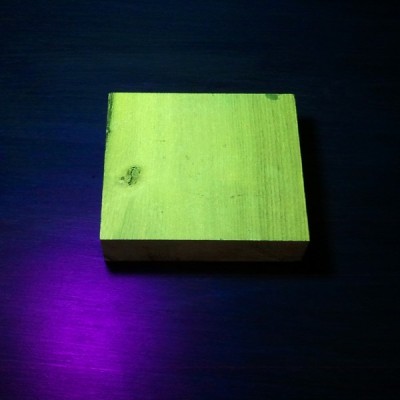
Chemical Testing
There are only a small number of chemical tests regularly used on wood, most of which are very specialized and were developed to help distinguish easily confused species with one another. They work by detecting differences in the composition of heartwood extractives. A chemical substance (called a reagent) is usually dissolved in water and applied to the wood surface: the surface is then observed for any type of chemical reaction (and accompanying color change) that may occur. Two of the most useful are the tests that are meant to separate Red and White Oak, and Red and Hard Maple.
Heartwood Extractives Leachability
Sometimes a wood species will have heartwood extractives that will be readily leachable in water and capable of conspicuously tinting a solution of water a specific color. For instance, the heartwood extractives contained in osage orange (Maclura pomifera) contain a yellowish-brown dye that is soluble in water. (This can sometimes be observed anecdotally when the wood is glued with a water-based adhesive: the glue’s squeeze-out is an unusually vibrant yellow.)
In a simple water extract color test, wood shavings are mixed with water in a vial, test tube, or other suitably small container, and the color of the water is observed after a few minutes. If the heartwood extractives are leachable by water, then a corresponding color change should quickly occur.
In addition to osage orange (Maclura pomifera), merbau (Intsia spp.), and rengas (Gluta spp. and Melanorrhoea spp.) are also noted for their readily leachable heartwood extractives. Because this property is quite uncommon, it can serve to quickly differentiate these woods from other lookalikes.
7. Look at the endgrain.
Perhaps no other technique for accurate identification of wood is as helpful and conclusive as the magnified examination of the endgrain. Frequently, it brings the identification process from a mostly intuitive, unscientific process into a predictable, repeatable, and reliable procedure.
Looking at the endgrain with a magnifier shouldn’t be a mystifying or esoteric art. In many cases, it’s nearly as simple as examining small newsprint under a magnifying glass. There are three components necessary to reap the full benefits contained in the endgrain:
I. A prepared surface.
When working with wood in most capacities, it becomes quickly apparent that endgrain surfaces are not nearly as cooperative or as easily worked as face grain surfaces. However, in this case, it is absolutely critical that a clear and refined endgrain surface is obtained.
For a quick glance of a softwood sample, a very sharp knife or razor blade can be used to take a fresh slice from the endgrain. However, in many denser species, especially in tropical hardwoods, one of the best ways to obtain a clear endgrain view is through diligent sanding. It’s usually best to begin with a relatively smooth saw cut (as from a fine-toothed miter saw blade) and proceed through the grits, starting at around 100, and working up to at least 220 or 320 grit, preferably higher for the cleanest view.
II. The right magnifier.
It need not be expensive, but whatever tool is used to view the endgrain should have adequate magnifying power. In most instances, 10x magnification is ideal, however, anything within the range of 8 to 15x magnification should be suitable for endgrain viewing. (Standard magnifying glasses are typically in the range of 2 to 4x magnification.)
These stronger magnifiers, sometimes called loupes, usually have a smaller viewing area than standard magnifying glasses. Fancier models—with built in lights, or larger viewing surfaces—are available at a premium; but the most basic models are usually only a few dollars.
III. A trained eye.
The third element that constitutes a proper endgrain examination is simply knowing what to look for. In analyzing the patterns, colors, shapes, and spacing of the various anatomical features, there is a veritable storehouse of information within the endgrain—all waiting to be unlocked. Yet, if these elements have not been pointed out and learned, the array of features will simply seem like an unintelligible jumble. The discipline of recognizing anatomical endgrain features is not easily summed up in a few sentences or even a few paragraphs, but it is nonetheless critical to the identification process. To this end, an in-depth look should be given to the various categories, divisions, and elements that constitute endgrain wood identification on the macroscopic level. (In this regard, macroscopic denotes what can be seen with a low-powered, 10x hand lens—without the aid of a microscope—rather than simply what can be seen with the naked eye.) Because the anatomy between softwoods and hardwoods is so divergent, each will be considered and examined separately:Still stumped?
If you have a mysterious piece of wood that you’d like identified, you’ve got a few options for next steps:USDA’s Forest Products Laboratory
You can mail your physical wood samples to the Center for Wood Anatomy Research.
Pros:
- Free
- Professional wood identification
Cons:
- Only available to US citizens
- Slow turnaround times (up to a month or more)
- Limited to three IDs per year
See their Wood ID Factsheet for more info.
Alden Identification Service
You can mail your physical wood samples (even small sections taken from antiques) to Alden Identification Service.
Pros:
- Professional wood identification
- Faster turnaround times (ranging from a few days to a week or two)
Cons:
- Paid service
See their ordering page for more info. (Note that Harry Alden has written several books while at USDA, including both Hardwoods and Softwoods of North America.)
Ask for help online
If the wood ID is merely a curiosity, or non-critical, you can post pictures of the wood in question.
Pros:
- Free
- No need to send physical samples
Cons:
- Greatly limited by the quality of the pictures provided
- Extra work usually required to get adequate clarity in photos
See article of Common US Hardwoods to help find the most commonly used woods.
Get the hard copy
 If you’re interested in getting all that makes The Wood Database unique distilled into a single, real-world resource, there’s the book that’s based on the website—the Amazon.com best-seller, WOOD! Identifying and Using Hundreds of Woods Worldwide. It contains many of the most popular articles found on this website, as well as hundreds of wood profiles—laid out with the same clarity and convenience of the website—packaged in a shop-friendly hardcover book.
If you’re interested in getting all that makes The Wood Database unique distilled into a single, real-world resource, there’s the book that’s based on the website—the Amazon.com best-seller, WOOD! Identifying and Using Hundreds of Woods Worldwide. It contains many of the most popular articles found on this website, as well as hundreds of wood profiles—laid out with the same clarity and convenience of the website—packaged in a shop-friendly hardcover book. 


Why I will no longer be replying to every wood ID request I’ve replied to literally thousands of wood ID requests on this site over the past 13+ years, but as the site’s popularity has grown, so has the time demands for ID on a daily basis. (Contrary to what some may seem to think, I am not some all-knowing wood wizard that can instantly ID your wood. It can actually take me a long time to sift through a lot of different resources.) Over the past few years, my backlog of pending wood species to be added to the… Read more »
Hi Eric
can you help please? Maple?
thx
Looks most like quilted maple.
Good morning – just got an antique writing box (the original laptop :)) the top and side were damaged by the spruce construction splitting at the knots and the veneer was irreparably damaged on 2 sides – I can repair/replace the substrate And i would like to match the Veneer as close as possible -can you identify the wood from these photos?
I can’t ID from those photos. Do you know where in the world this item originated from? That might help narrow things down.
This is a Sewing Table (Singer Model 40) from 1929. The veneer is in decent shape, but I need to do some repairs. I’m not sure what wood it is. The front is in pretty good shape, I’ve scraped the top. I have included an image of the top dry and with a wipe of mineral spirits to show the wood grain/color better.
Very hard to tell from pics. But on the top, it looks like a semi-ring-porous hardwood with a single row of pores, so possibly a Juglans species such as walnut or butternut.
Thanks. My curiosity is driven by picking the correct veneer for a repair. I’m a novice, so I’m not sure if picking the correct wood or picking a wood with a similar color? In your opinion, which veneer species should I be looking at? Walnut? Thanks again Eric
If I were just trying to match appearance, you might try butternut as it has more of neutral color, and then try to color match it using stains or dyes.
Hey, I found an article that the 1926 version of this machine’s table (model 40) was made out of Walnut stained in mahogany or brown mission. So, that’s a bingo for you my man! Well done, I’ll grab some walnut veneer and get this guy fixed up. https://www.singersewinginfo.co.uk/tables
Hi Eric-Just stumbled across your site. Found this bed at an estate sale. Started to clean it up and was curious about the type of wood. Fairly lightweight. Pics taken in natural light. Thanks!!
Sorry, there’s still too much old finish and stain obscuring the grain, so I can’t tell much yet.
My father-in-law just rescued this beautiful piece from a family that was going to set fire to their old family home with everything in it! I’m wondering if you’re able to identify the type of wood? Thanks!
The drawer fronts appear to be veneered, and remind me of figured tamo ash. Initially I was thinking the rest was made of oak, but since the drawer fronts may be ash, there’s a chance the whole thing was made from ash to maintain species consistency.
Any thoughts? Storage cabinet purchased from a local “exotic” furniture store. Fairly hard and light orange in color. Appears to have been lightly oiled but no finish coat. Second pictures shows end grain. Thank you for your time!
I could very well be wrong, but my gut tells me its mesquite. Most common mesquite seen would be honey mesquite, so that’s my vote.
Thank you, sir! I will continue my research from there. Have a nice week.
Can you help me to identify the wood of this european panel dating back to the XV century?
That’s pretty weathered, very hard to tell without getting a closer look at the endgrain once it’s been cleaned up. However, it appears to be a ring porous hardwood, so oak (or possibly ash) would be leading contenders.
This is a Danish piece probably from around 1970. Is it walnut or rosewood?
Hard to tell from that distance and pic is low resolution, but it does resemble walnut.
This is from an old woodworking shop in South Texas. I have no idea but have quite a bit of it. It’s heavy and hard but seems to be porous. I don’t know how old it is. But if you get a splinter, Heavens to Betsy, it’s a fierce reaction. Any idea?
Thanks for all the outstanding replies! Yeoman’s work. Truly a great job.
Two common names are applied to this wood, leopardwood and lacewood. On this website, I’ve tried following the majority consensus and have referred to it as leopardwood. (Lacewood is similar in appearance but is softer and lighter in color.)
i wanted to make knife scales from this wood but have no idea what it is. it changes color depending on the angle you look at it.. can you help?
Do you know what region of the world the wood came from? Where are you located? I can’t tell from the pics, but that color change you see is called chatoyance.
I need help identifying this type of wood.
The flooring looks like southern yellow pine.
Heavy end tables, original stain had reddish tones. I have sanded these and plan to refinish them but I am a first timer doing this and it would help to know what type of wood this is. Can you tell from the attached?
I can’t tell from the pic, sorry.
This is an old (60-80 years, maybe more) gun rack from northern Minnesota. I’d like to find a board to match/compliment it, so I can add one more gun than the rack holds. Can you tell me what it is, and/or what would be a good wood to go with it?
It’s hard to tell if that’s even a softwood or a hardwood from the pics. It could be pine, but it could also be something like birch or maple, with its reddish brown heartwood included. Or possibly the drawer front was made from a different wood than the rest of the rack.
I was given this antique desk that was reportedly built in the late 1800’s – early 1900’s. The family who gave it to me are from the Midwest and WA state. Could you tell me what type of wood it is?
That’s solid oak. I can’t quite tell from the pics if it’s red or white, but I’m leaning toward red oak.
Can you tell me what kind of wood this is?
The stuff on the right looks like maple.
Do you know what this is?
Looks like black walnut.
Very hard/dense red/burgundy coloured wood. Speckled grain pattern and waxy feel. Suspect teak but looks too dark from normal teak I’ve seen. Tight end grain too and hard to cut on table saw.
Apparently the photos didn’t upload
Looks like ekki. https://www.wood-database.com/ekki/
Do you know what type of wood this is?
I can’t tell from that pic, sorry
another pic of the front and of the side in case it helps.
I’m spending a considerable amount on what’s meant to be a solid oak door, but it doesnt quite look as I expected.
Can confirm it is oak, and it is solid.
that’s great thank you, much obliged Eric!
Hi Eric. I just purchased this wardrobe for $10 at a Goodwill in Asheville North Carolina today. Any idea what kind of wood the exterior wood is? It’s sort of lightweight. I haven’t seen that actual design or striations and Wood before.
I’m completely stumped, not sure. I agree it does look unique. I see ray flecks on the front, so it might be something in the Proteaceae family.
Hello. I recently purchased 5 live edge slabs (pictured), and the seller and I are wondering what species. We were guessing white walnut, hackberry, or chestnut. Your thoughts are greatly appreciated before we convert these into epoxy resin river tables.
Looks like some pretty nice stuff, very colorful. I can’t tell what they are, can you get a cleaned-up, clear, closeup picture of the endgrain by chance?
Thank you. It’s definitely some really nice stuff. The seller and I have been working on determining what it is but I’ll get a close-up of the endgrain ASAP
Eric,
Here are two pictures that I hope our clear enough to see. One of them is the end green and one of them is a close-up of the green of one of the five slabs. Hopefully it helps
Thanks, the endgrain image still isn’t close enough to see the anatomy of the wood. Basically, try to get as close to the wood as your camera will allow and still be in focus. My initial reactions are possibly some sort of fruitwood, possibly cherry.
Hi This is an old table and I can’t figure out if it’s real wood or not
Looks like some pretty beat up walnut veneer. Hard to tell, but it looks like chunks of veneer might be falling out or otherwise damaged, which, if true, would be a real shame as walnut veneer can look really nice when finished well, but is very difficult to repair in these sorts of situations. (Walnut is the darker outer wood, and underneath is a lighter colored substrate which should remain covered.)
Okay that’s helpful! This is a better pic of the wood
Those new pics don’t shed much additional light, sorry. Looks like it was darkly stained, and it’s very hard to see much wood grain in the photos.
This is a door from my bathroom vanity. It is 35 years old I just sanded them down and refinished them. I am pretty sure its a vaneer but not sure what KIND. my kitchen cabinets are the same material and i would like to identify the wood before i start stripping them .
Looks like maple or birch. If it’s a veneer, then it’s much more likely that it’s just birch veneer plywood, very common.
Hi, any chance you could advise what type of wood these floorboards are?
I’ve sanded a small part of one board which can be seen in the pics. Is the orange colour an aging effect where the wood would typically be yellow when originally installed?
Thanks for any help you can give.
This is from a 100 year old house in Scotland. I’m hoping to sand and varnish the floors but need to replace a few boards first.
Please attach pics, they didn’t come through.
Hopefully this worked
Still nothing, sorry
Hi Eric, do you know what wood this mirror frame would be?
(I’m also trying to identify what creature has burrowed into it, but that’s a whole other story!) Thanks!
Well, it’s a diffuse porous hardwood with extensive ray flecks. That’s a good closeup picture, but it’s hard to get a sense of scale of how big everything is. Also, where are you located? Right now my best guess based on ray fleck pattern is sycamore.
Hi Eric – you’re amazing, thank you. I’m attaching a few more pics for scale. I’m in the UK (East Anglia) The mirror was given to me about 20 years ago.
It does look a lot like sycamore, and based on your location, I’d say it’s more than likely London plane tree.
Thank you so much, Eric!
Hello! I am having a hard time figuring out what wood this butcher block table is. Just started sanding.
Hard maple.
Thank you very much! What a lifesaver! Now I can research finishes and know what I will actually get.
What is this piece ?
Around 2.7kg for a 10in x 10in x 2.5in piece
Smells likes the red pen in the pics
If I remember correctly when I picked it it was apple but I want to be sure as I’m gonna try making tobacco pipe with it if it’s not toxic
I can’t make out enough details in the endgrain pics to say for sure, sorry! At the very least, I don’t see anything that would definitively rule out apple yet.
Hi there! Any idea what this is?
Looks like an antique table made with birdeseye maple with a golden brown stain.
Can you help me identify my floors?
Looks like a softwood species, possibly a species of southern yellow pine.
Do you have any idea what this might be? The black bits are the stain we haven’t sanded off yet. Thank you!
Looks like pine, possibly a species of southern yellow pine.
Any ideas?
Looks like weathered or distressed wood, but I can spot that some of it is from the large rays, which would suggest possibly a species of oak.
Thank you!
Hello, can you help me identify these wood? Its heavy and it came from US
(Not sure if the top and the body have the same wood, but the body seems like a solid or more durable wood than the top, but not sure tho, or maybe they’re the same. idk) help
I can’t tell from the pics, sorry. It appears to be a type of diffuse porous tropical hardwood.
Hi there wondering if you know what kind of wood this is. Do you think it is veneer. Looking to refinish it. Thanks
It’s definitely veneered, and it’s a pretty stunning top too. The mirrored patterns like that are really only accomplished with bookmatched, sequential veneer pieces. A few guesses might be a species of Cordia like bocote or ziricote, or depending on age, maybe even Brazilian rosewood.
Thanks
Hi! I have this table and it is the heaviest thing on earth! I thought it would be pine but I have never lifted a pine throat heavy! I can barely lift an END of the table. It’s pretty pale in color under the stain. Any help would be appreciated! Thank you so much!
Yes, looks like a softwood like pine that’s been stained a very dark brown. Probably heavy because it appears to be very thick (possibly made from 2x construction material).
Could you tell me what wood this dining table is please. It’s hand crafted and very heavy
It doesn’t look like anything familiar, and I can’t tell from the pic, sorry.
Can you please identify this wood type ? And what are those dark black spots ?
Looks like a softwood species of some sort, can’t tell from the picture. Those darker spots is fungal discoloration, and they can appear if the wood is not dried fast enough after felling the tree. They generally affect the lighter sapwood on the edges more than the heartwood as the sapwood is more susceptible to fungus and other problems.
Hi Eric, any idea which wood this massage tool could be made from?
Looks like a pretty basic softwood like pine.
Thank you!
Any idea what kind of wood this is? Slab is 68” x 28”. It was my dad’s and he kept talking about Purple Heart wood, but this does not look especially purple to me
I can’t tell from the picture but it sure doesn’t look like any purpleheart that I’ve seen.
Can you tell me what type of wood this is please
I can’t tell the species for certain from the pictures, but it is a grain pattern from the point where a branch diverges from the trunk, called crotch veneer. The two most common species that this is seen in is mahogany and walnut, and to me, if I had to guess, I’d say is crotch mahogany veneer.
inherited part of Dad’s veneer collection. Any idea?
My initial thought was quartersawn oak but the ray fleck doesn’t look right. The fact that it’s a veneer suggests something like lacewood or silky oak.
House was tore down in Lancaster PA. It was over 150 years old I was able to salvage from the scrap could you help identify these.
Wood on the right looks like white oak. Left is a softwood of some sort, based on its weight, probably a species of southern yellow pine.
End grain better color
Yes, this endgrain looks very much like a species of oak. It’s too rough cut to make out if there are tyloses or not, so I can’t tell if red vs white oak species.
Hello and Thank You so much for the insight. As I have always been interested in wood working now that I am older I am taking the steps and feel the need for total education in my interest.
I like that others have posted pictures of woods in question and you have had no problem helping with that.
So if nobody else does I would also like to thank you for that.
Have a Good Day
J, David
Hi Eric, this timber has come from an old building on the docks of the Wirral. They are in 2m lengths and wondering if you could identify.
The endgrain resembles species of Eucalyptus, so possibly an imported wood. If I had to take a guess, I might say something like karri. Maybe someone from the UK has a better idea…
Thankyou so much for the reply! I don’t know how you find the time to reply to all these messages but thankyou you are appreciated!! We’ve decided to make a dining table from these pieces and would love to send you a pic once complete.
Any idea what kind of wood this is? It’s the staircase I stripped the paint from in a house I purchased built in 1900.
What region is the house located?
It’s in upstate NY, ulster part in esopus it’s an old farm house if that helps.
Superficially it resembles one of the pale-colored hardwoods common in the US, such as maple or birch. But I can’t make out enough detail to say for sure. A shot of the endgrain or possibly just closer and under better lighting might give more detail.
That was supposed to say ulster park..
I got this awesome coffee table still trying to figure out what it came from, any ideas?
I can’t tell, it looks like some sort of burl wood. Is it fairly lightweight for its size, or heavy? Where is the table located?
Hi, would you please confirm…my guess is black walnut?
I can’t make out very much detail in the picture, but I agree that it looks most like black walnut.
Thanks!
Hello, can you please help me identify this wood veneer? It’s the lid of a baby grand piano, of Continental European origin, build in the 1880s, most likely stained. Many thanks!
Looks like a hardwood, possibly oak or beech?
Found these in my 1950 cottage crawlspace. They are 2*12s and measure a bit bigger than modern, 1.75 x 11 5/8 or so
I have china cabinet that I would like to refinish, but want to know what wood it’s made out of first. Can you help me identify it? I’ve sanded the finish a bit on one of the shelves. My guess is a cherry veneer.
I can’t tell from the pics, sorry.
My boyfriend and I are re-finishing an old French Mirecourt double bass (est. 1900-1920) and were wondering if you had any perspective on what type of wood the back panelling is. We’ve tried to remove as much varnish as possible, and it’s definitely been scratched up. I thought it looked a little like honey locust but the grain seemed to be different. Some have thought it was bird’s eye maple, or Syracuse. Any thoughts are appreciated!
That grain pattern is pretty unique, and it’s not birdseye maple. It looks like ray fleck. The closest thing I’ve seen to that would be a species of silky oak or lacewood.